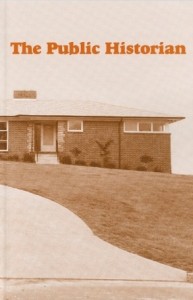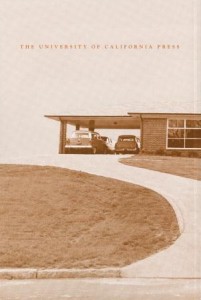Update on the Journal
01 May 2012 – John Dichtl
 At the OAH/NCPH Annual Meeting in Milwaukee, NCPH President Marty Blatt, Vice President Bob Weyeneth, and Executive Director John Dichtl sat down with the chair of the history department at the University of California Santa Barbara, John Majewski, and the Editor of The Public Historian, Randy Bergstrom, to discuss the future of The Public Historian and housing the editorial offices at UCSB in partnership with NCPH. We agreed to establish an interim two-year agreement, through December 2014, during which we will explore various options for the future of the journal: continuing the partnership between NCPH and UCSB, adding additional institutions to the partnership, or going separate ways in a prepared and amicable transition. The agreement itself needs to be drafted and will need to be approved by UCSB’s Dean of Humanities and Fine Arts and NCPH’s Board of Directors, but both sides are optimistic. It was a cordial and constructive meeting, looking toward the future.
At the OAH/NCPH Annual Meeting in Milwaukee, NCPH President Marty Blatt, Vice President Bob Weyeneth, and Executive Director John Dichtl sat down with the chair of the history department at the University of California Santa Barbara, John Majewski, and the Editor of The Public Historian, Randy Bergstrom, to discuss the future of The Public Historian and housing the editorial offices at UCSB in partnership with NCPH. We agreed to establish an interim two-year agreement, through December 2014, during which we will explore various options for the future of the journal: continuing the partnership between NCPH and UCSB, adding additional institutions to the partnership, or going separate ways in a prepared and amicable transition. The agreement itself needs to be drafted and will need to be approved by UCSB’s Dean of Humanities and Fine Arts and NCPH’s Board of Directors, but both sides are optimistic. It was a cordial and constructive meeting, looking toward the future.
While the precise terms of the interim agreement are not yet finalized, here are some of the specifics that NCPH and UCSB expect to be included. UCSB will hire a new managing editor for The Public Historian in 2012. Randy Bergstrom will remain as editor and may be joined by a co-editor from within UCSB or a public historian from outside the university. The current Editorial Board will continue in the same way it has been operating, and the NCPH president will continue to appoint new members in consultation with The Public Historian editor/co-editors and managing editor. NCPH members will continue to receive The Public Historian as a benefit of membership at least through 2014.
Because there has been intense membership interest in the negotiations between NCPH and UCSB on the future of the journal, it is important for all to understand what has led to this interim agreement. First the broad outlines of the timeline. The Public Historian was founded at UCSB in 1978 and has been edited there ever since. It is published by the University of California Press for UCSB and NCPH. NCPH has a publishing contract with UC Press and UCSB, as well as a separate contract with UCSB for housing the editorial office. It is the latter contract that has been under discussion, because it expired in 2009. In this sense, this most recent round of negotiations has been going on for the last three years. Since 2009, and particularly throughout 2011, NCPH and UCSB discussed the nature and level of support for the editorial offices as proposed for future years by UCSB. All of the UCSB proposals would have represented a change from the current editorial arrangement, including changes in material support; there was never an option of status quo continue-as-usual. These discussions were eventually unsuccessful in producing an extension of the contract. As a result, the NCPH Board of Directors voted to terminate the relationship with UCSB, effective January 4, 2013. The tentative interim agreement reached in Milwaukee would unite NCPH and UCSB for an additional twenty-four months, from January 4, 2013, to December 31, 2014. That’s the big picture of how we got to where we are today.
All of us hope that this interim arrangement will address the issues that surfaced as NCPH and UCSB were attempting over the past couple of years to reach agreement on extending the 2009 contract. During these discussions, the parties had a series of candid conversations about the current California and UCSB budget situations and their likely trajectory. We discussed both impending and approaching personnel changes of which NCPH was made aware. We discussed various proposals for the future of the journal’s editorial offices that incorporated these budgetary and staffing realities as a way to keep the offices at UCSB. We also tried to imagine new partnerships with other universities and public history institutions. As important as anything, we discovered two complex issues on which each party learned it had its own views. First was a set of legal questions related to the ownership of trademark (or the right to use the name The Public Historian) going forward. Second were financial concerns related to an appropriate future allocation of revenues from institutional subscriptions.
It had never been NCPH’s intention to terminate the relationship with UCSB as it went into discussions on extending the contract. However, as business negotiations continued into 2011, the NCPH Board of Directors realized it needed to begin contemplating a contingency plan to protect the organization and the journal. Consideration was given to finding a potential new home for the editorial offices should the negotiations founder. Pursuing this alternative was complicated because of the continuing and differing views about trademark. The NCPH Board went so far as to prepare a draft Request for Proposals, but it was precluded from issuing the RFP when it learned it would have to include disclaimers related to UCSB’s claim on trademark that would have rendered the RFP ineffective in soliciting proposals. NCPH did test the waters informally with a half-dozen institutions within the public history community to gauge general interest for hosting a journal, perhaps on a rotating basis for five to seven years, which is a common model for many academic journals. Without the option of an RFP and with negotiations appearing unproductive, NCPH approached American University and the Smithsonian Institution, which had indicated some initial interest in response to an NCPH inquiry. While the contours of a potential NCPH-AU-SI partnership were coming into focus as a potential “lifeline” in a difficult situation, NCPH also explored the idea of creating a partnership editorial arrangement linking UCSB with American University and the Smithsonian Institution. In the end, though, NCPH could not make the details work for this “grand collaboration.”
This is the background and context for the Board of Directors’ decision to terminate. We appreciate that it may have seemed abrupt to many in the membership. However, much of the content of the discussions involved delicate, often confidential, legal, financial, and personnel issues. The good news is that this is now a matter for full public discussion. The 90-minute Open Forum was added to the Milwaukee program in order to create a venue for answering questions about the business negotiations that have led us to this point. We were especially pleased that Randy Bergstrom was able to join Marty Blatt, Bob Weyeneth, and John Dichtl on the dais for the give-and-take of this discussion.
We remain grateful for the support and flexibility of colleagues at American University and the Smithsonian Institution during the past several months and for their willingness to help reimagine a public history journal.
This synopsis is intended to provide background for members who were unable to attend the Milwaukee conference, as well as to stitch together a more comprehensible narrative of the recent history for everyone. It is also intended to point us in the direction of moving forward. NCPH has formed a task force charged with envisioning a journal for the 21st century. It will work with the current Public Historian Editorial Board members and staff—as well as with the full NCPH membership—to imagine what a public history journal should look like, as the field becomes increasingly global and digital. We are interested in exploring how digital media can be used to enhance and inform publication; how the journal can intersect with other publications and communication venues such as social media; what new kinds of article, discussion, and review formats can be incorporated within the journal; and how current readers and new audiences want to use the journal. NCPH welcomes input and ideas from all public historians, both members and non-members. These are exciting times for our field, with the possibilities of digital directions and internationalization on everyone’s mind. Help us envision the future.
Bob Weyeneth
University of South Carolina
NCPH President
[email protected]
John Dichtl
NCPH Executive Director
[email protected]
For a summary of the Open Forum, see
http://ncph.org/history-at-work/elephant-in-the-conference-room-the-public-historia/




Thank you, Bob and John, for continuing this open communication and for pulling together a timeline of events.
I hope we can use this opportunity to create not simply a new journal but a new kind of journal that better reflects the any various roles of public historians. And I hope that the new journal will be available to the public to read online, and not locked away via JSTOR so the public cannot read it.
I posted my thought here: JSTOR is Not Our Friend; or, What Should a New Public History Journal Look Like? http://northwesthistory.blogspot.com/2012/04/jstor-is-not-our-friend-or-what-should.html